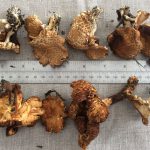Today’s plant dye vats are a bit smelly. Partly due to the mordants I have used and partly to a long fermentation (mostly because I forgot about them and left the dyestuff solution sitting outside for several weeks). This could be a good thing though, as fermentation helps to extract the dye from the plants.
Birch Bark Dye

30 grams of chopped Birch Bark
Isopropyl Alcohol
Steeping in a jar for several weeks. The dyestuff has turned a nice shade of pink. I put the dye stock into a dyepot filled with water and let it simmer for several hours.
Then I added pre-mordanted handspun flax into the dye pot, let it simmer for 2 hours and turned the heat off. I left the yarn to sit in the dyepot overnight. Wonderful colour!

There was still a lot of colour left in the dyepot so then I put a cotton tote bag into the pot.

Fungi Dye
A few weeks ago, I discovered what looked like Sarcodon imbricatus (that grow under pine trees) or Sarcodon Squamosus (that grow under spruce trees) fungi growing amongst the bark mulch in our garden. I couldn’t identify which type of bark mulch we have so don’t know whether these will yield any nice colour, but this will be a good experiment none the less.
In Norway, fungi dyers have had good success in producing green and blue dyes using Sarcodon fungi. I had heard that Sarcodon produce better colour when picked in the late fall, so I thought that perhaps freezing them would help to bring out the dye pigment, if there is any. I cut the fungi into small pieces, put them into a plastic container and added a bit of water – and into the freezer for a few weeks.
When I took them out of the freezer, I added a few drops of ammonia to change the pH to alkali, and let the fungi sit outside for a few weeks.
After this fungi mixture had fermented, I strained the fungi into a mesh bag and put it all into a dyepot filled with water to simmer for a few hours.
Result:

Disappointing grey/brown on handspun bleached flax. The plant dye world doesn’t always produce colourful results, but interesting to try.
Lichen
After a particularly windy night, I took a short walk along the Canal near our house. The wind had knocked down a lot of tree branches that were covered with lichen. I gathered some of them up and took them home. I am not very familiar yet with lichens of the UK, but I think this is xanthoria parietina, which should produce yellow dyes. I scraped the lichen off the branches and put them into an organza mesh bag.
I put the lichen dyestuff into a dyepot, added water and let the dye stock simmer for a few hours.
Some Xanthoria parientina have 2 dye pigments, yellow and red. The red pigments can also produce pinks, plums and blues when fermented in ammonia. To test whether the xanthoria will produce the red shades, add a bit of household bleach to the lichen. If it turns red, then the dyestuff can be fermented.

The cotton bag didn’t turn red but is a pretty shade of soft pink. I suppose a lot more lichen would be required to get deeper colour.

If you would like to shop for one my Flora dyed Market Tote bags, please visit my Spin Flora Shop at Etsy for the latest selection.
If you would like more information about the Flora dye workshops that I offer, please visit Paivatar Yarns.
Please visit and like my Spin Flora Facebook page if you would like to be updated on my latest work.





